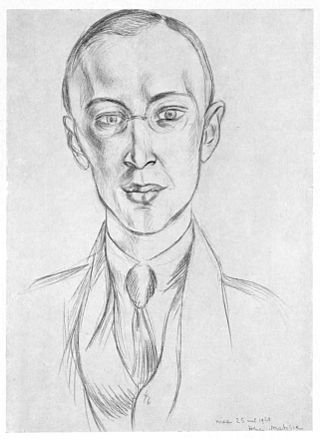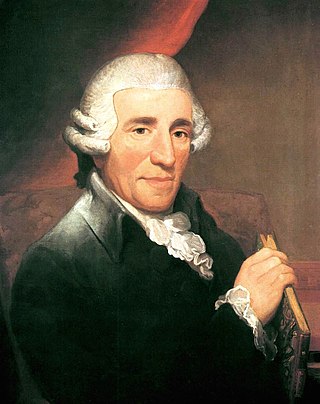Related Research Articles
Sonata form is a musical structure generally consisting of three main sections: an exposition, a development, and a recapitulation. It has been used widely since the middle of the 18th century.
The Piano Sonata No. 16 in C major, K. 545, by Wolfgang Amadeus Mozart was described by Mozart in his own thematic catalogue as "for beginners", and it is sometimes known by the nickname Sonata facile or Sonata semplice.
Ludwig van Beethoven's Piano Sonata No. 8 in C minor, Op. 13, commonly known as Sonata Pathétique, was written in 1798 when the composer was 27 years old, and was published in 1799. It has remained one of his most celebrated compositions. Beethoven dedicated the work to his friend Prince Karl von Lichnowsky. Although commonly thought to be one of the few works to be named by the composer himself, it was actually named Grande sonate pathétique by the publisher, who was impressed by the sonata's tragic sonorities.
![<span class="mw-page-title-main">Symphony No. 41 (Mozart)</span> Last symphony by [[Wolfgang Amadeus Mozart]]](https://upload.wikimedia.org/wikipedia/commons/thumb/b/ba/Mozart_by_Posch_Wien_SAM_841.jpg/320px-Mozart_by_Posch_Wien_SAM_841.jpg)
Wolfgang Amadeus Mozart completed his Symphony No. 41 in C major, K. 551, on 10 August 1788. The longest and last symphony that he composed, it is regarded by many critics as among the greatest symphonies in classical music. The work is nicknamed the Jupiter Symphony, probably coined by the impresario Johann Peter Salomon.

Ludwig van Beethoven's Piano Sonata No. 29 in B♭ major, Op. 106 is a piano sonata that is widely viewed as one of the most important works of the composer's third period and among the greatest piano sonatas of all time. Completed in 1818, it is often considered to be Beethoven's most technically challenging piano composition and one of the most demanding solo works in the classical piano repertoire. The first documented public performance was in 1836 by Franz Liszt in the Salle Erard in Paris.

Ludwig van Beethoven's String Quartet No. 11 in F minor, Op. 95, from 1810, was his last before his late string quartets. It is commonly referred to as the "Serioso," stemming from his title "Quartett[o] Serioso" at the beginning and the tempo designation for the third movement.
Sonata rondo form is a musical form often used during the Classical and Romantic music eras. As the name implies, it is a blend of sonata and rondo forms.

Sergei Prokofiev's Symphony No. 4 is actually two works, both using material created for The Prodigal Son ballet. The first, Op. 47, was completed in 1930 and premiered that November; it lasts about 22 minutes. The second, Op. 112, is too different to be termed a "revision"; made in 1947, it is about 37 minutes long, differs stylistically from the earlier work, reflecting a new context, and differs formally as well in its grander instrumentation. Accordingly there are two discussions.

Beethoven's Piano Sonata No. 21 in C major, Op. 53, known as the Waldstein, is one of the three most notable sonatas of his middle period. Completed in summer 1804 and surpassing Beethoven's previous piano sonatas in its scope, the Waldstein is a key early work of Beethoven's "Heroic" decade (1803–1812) and set a standard for piano composition in the grand manner.
Ludwig van Beethoven's Piano Sonata No. 3 in C major, Op. 2, No. 3, is a sonata written for solo piano, composed in 1795. It is dedicated to Joseph Haydn and is often referred to as one of Beethoven's earliest "grand and virtuosic" piano sonatas. All three of Beethoven's Op. 2 piano sonatas contain four movements, an unusual length at the time, which seems to show that Beethoven was aspiring towards composing a symphony. It is both the weightiest and longest of the three Op. 2 sonatas, and it presents many difficulties for the performer, including difficult trills, awkward hand movements, and forearm rotation. It is also one of Beethoven's longest piano sonatas in his early period. With an average performance lasting just about 24–26 minutes, it is second only to the Grand Sonata in E♭ Major, Op. 7, published just a year later, in 1796.

The Symphony No. 96 in D major, Hoboken I/96, was completed by Joseph Haydn in 1791 as part of the set of symphonies composed on his first trip to London. It was first performed at the Hanover Square Rooms in London on 11 March 1791. Although it is the fourth of the twelve London symphonies by number, it was actually the first one written and performed. It is popularly known as the Miracle Symphony.

The Violin Sonata No. 1 in A minor, Op. 105 of Robert Schumann was written the week of 12– 16 September 1851. Schumann was reported to have expressed displeasure with the work. This was also the year of the premiere of the Rhenish symphony, and among compositions the substantial revision of the Fourth Symphony, the Third Piano Trio, the oratorio Der Rose Pilgerfahrt, a number of piano works and two of his concert overtures, Julius Caesar and Hermann und Dorothea after Goethe.

The Symphony No. 100 in G major, Hoboken I/100, is the eighth of the twelve London symphonies written by Joseph Haydn and completed in 1793 or 1794. It is popularly known as the Military Symphony.
Piano Sonata No. 15 in D major, Op. 28, is a piano sonata by Ludwig van Beethoven. The name Pastoral or Pastorale became known through A. Cranz publishing of Beethoven's work, but was first coined by a London publisher, Broderip & Wilkinson. While not as famous as its immediate predecessor, Piano Sonata No. 14, it is generally admired for its intricate technicality as well as for its beauty. The sonata takes roughly twenty-five minutes to play with its intended repeats.
Beethoven's Piano Sonata No. 11 in B♭ major, Op. 22, was composed in 1800, and published two years later. Beethoven regarded it as the best of his early sonatas, though some of its companions in the cycle have been at least as popular with the public.
Cello Sonatas No. 1 and No. 2, Op. 5, are two sonatas for cello and piano written by Ludwig van Beethoven in 1796, while he was in Berlin. While there, Beethoven met the King of Prussia Friedrich Wilhelm II, an ardent music-lover and keen cellist. Although the sonatas are dedicated to Friedrich Wilhelm II, Ferdinand Ries tells us that Beethoven "played several times at the court, where he also played the two cello sonatas, opus 5, composed for Duport and himself". Although Jean-Pierre Duport was one of the King's teachers, it is now thought to have been his brother Jean-Louis Duport who had the honor of premiering these sonatas.
The Piano Sonata No. 3 in F minor, Op. 5 of Johannes Brahms was written in 1853 and published the following year. The sonata is unusually large, consisting of five movements, as opposed to the traditional three or four. When he wrote this piano sonata, the genre was seen by many to be past its heyday. Brahms, enamored of Beethoven and the classical style, composed Piano Sonata No. 3 with a masterful combination of free Romantic spirit and strict classical architecture. As a further testament to Brahms' affinity for Beethoven, the Piano Sonata is infused with the instantly recognizable motive from Beethoven's Symphony No. 5 during the first, third, and fourth movements. Composed in Düsseldorf, it marks the end of his cycle of three sonatas, and was presented to Robert Schumann in November of that year; it was the last work that Brahms submitted to Schumann for commentary. Brahms was barely 20 years old at its composition. The piece is dedicated to Countess Ida von Hohenthal of Leipzig.

Johannes Brahms's Violin Sonata No. 3 in D minor, Op. 108 is the last of his violin sonatas, composed between 1886 and 1888. Unlike the two previous violin sonatas, it is in four movements. The sonata is dedicated to Brahms' friend and colleague Hans von Bülow, and was premiered in Budapest in 1888 with Jenő Hubay on violin and the composer at the piano.
Franz Schubert's Piano Sonata in D major D. 850, Op. 53, known as the Gasteiner, was written during August 1825 whilst the composer was staying in the spa town of Bad Gastein. A year later, it became only the second of his piano sonatas to be published.
Nikolai Myaskovsky wrote his Symphony No. 9 in E minor, Op. 28, between 1926 and 1927. It was dedicated to Nikolai Malko.
References
- ↑ "Source for Movement Headings". Myaskovsky.ru. Retrieved 24 November 2009.